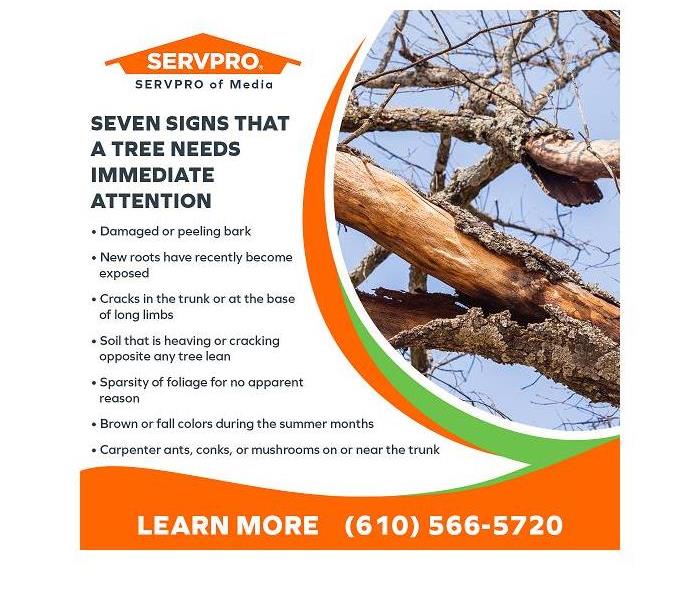Signs of Tree Damage and What to Do in the Case of Storm Damage from a Fallen Tree
10/11/2022 (Permalink)
Blog Summary: SERVPRO of Media offers tips on how to spot tree damage and how to take care of storm damage from fallen trees and limbs.
SERVPRO® of Media is available 24/7, 365 days a year, including holidays, to provide storm damage cleanup and restoration services for Media, PA, homes, and businesses. In September of 2021, the remnants of Hurricane Ida dumped nearly five inches of rain on the metro Philly area, including Lancaster County. Some areas received over nine inches of rain. Flash flooding and strong winds accompanied the rain. The winds, in conjunction with the saturated soil, resulted in toppled trees, broken limbs, and downed power lines. Many homes suffered structural damage from the flooding and from the storm-damaged trees. The team at SERVPRO of Media offers this advice on tree care to help residents maintain a healthy, beautiful, and safe treescape.
Signs a tree is a potential risk during storms
All trees are vulnerable to the forces of nature. The cold months bring the threat of ice, sleet, and snow. During the warmer months, high winds and rainfall can put trees in jeopardy. High winds can cause limb loss. In extreme conditions, a tree may topple over, creating a domino effect throughout the canopy in which other trees fall or are damaged. If the trees are near a home or business, storm damage to the structure is inevitable. Here are some signs that a tree may be susceptible to limb loss or toppling over during a storm.
Factors contributing to tree failure
Many factors can compromise tree strength and stability. Decay, tree wounds, and shallow root systems are some leading culprits. Normally, a tree’s root system spreads out almost half as much as the canopy, but in urban areas where construction is very active, a root system can be damaged by grading, trenching, and excavating. Encroachment can hinder the outward spread of roots, which not only deliver nutrition but also serve as anchors. A compromised root system puts a tree at risk of windthrow, the technical term for uprooting or toppling.
Tree selection in a subdivision may result in trees with root systems that function best in forests. However, these trees are sometimes transplanted in soil that is shallow or rocky. Once the trees reach maturity, the soil hinders the root system from firmly anchoring the trees. The mature trees are vulnerable to windthrow and put the homes in the neighborhood at risk of property damage should the trees topple over during severe weather.
A treescape with an integrated network of tree limbs and root systems may withstand powerful winds. However, efforts to thin the treescape can leave the remaining trees vulnerable to high winds.
Tall trees are at greater risk of toppling than shorter trees. Tall, fully-leaved trees catch the wind, which transfers lever-like power to the trunk. The forces can rip the tree out of the ground. Broken limbs, peeling bark, and scraped wounds make a damaged tree susceptible to a pest infestation, further rot, and possibly the need to be removed.
Trees, in general, are at risk if wind speeds are high. Some tree varieties have less resilience to withstand wind force. Examples include Bradford pear, balsam fir, cedar, and white spruce, as well as older water oaks, older willow oaks, some hemlocks, and several varieties of pine trees.
How to inspect a tree
Visually inspect the tree from top to bottom, from a distance, and from close by. Use binoculars, if necessary. Drone technology is affordable and accessible to assist with examining the treescape.
Note any of the following issues:
- Deadwood or brown leaves in the crown of the tree
- Wounds caused by prior limb loss
- Unusual lean (which may indicate damage to the anchor root or unequal weight distribution from rot and disease)
- Multiple trunks (in the shape of a ‘U’ or a ‘V’)
- Splits in one or more trunks
Also, note ground disturbances from trenching, ditch digging, grading, and tilling activity within the bounds of the tree canopy. Construction near trees, including driveways, walkways, a garden, or utility line work, can damage shallow feeder roots and destabilize a tree.
Seven signs that a tree needs immediate attention
- Damaged or peeling bark
- New roots have recently become exposed
- Cracks in the trunk or at the base of long limbs
- Soil that is heaving or cracking opposite any tree lean
- Sparsity of foliage for no apparent reason
- Brown or fall colors during the summer months
- Carpenter ants, conks, or mushrooms on or near the trunk
Tree safety action steps
Immediate action steps are necessary to keep the area under the tree canopy safe and to prevent storm damage from falling trees and limbs.
Step #1: Contact a bonded, insured, and certified arborist to schedule an onsite consultation. Some issues can be remedied with treatments for disease and strategic pruning. Removal may be required in some instances.
Step #2: Take extreme precautions to stay safe. Cordon off the high-risk area around the tree. Relocate vehicles at a safe distance from damaged or dangerous trees. Stay out of the part of the home that would be damaged if the tree suffered a catastrophic failure.
Storm damage cleanup and restoration
If a limb or tree should puncture the roof or house envelope, contact the professional storm damage cleanup and restoration team at SERVPRO® of Media, PA, for emergency tarping, water removal, drying, and dehumidification. The water and moisture need to be within acceptable levels to prevent advanced secondary damage, including a mold infestation. SERVPRO can handle the cleanup and restoration, including major repairs to the roof, ceilings, walls, and flooring.
For more information about storm damage restoration in Broomall, PA, and surrounding areas, contact SERVPRO of Media by calling (610) 566-5720 or by emailing office@SERVPROmedia.com.






 24/7 Emergency Service
24/7 Emergency Service
